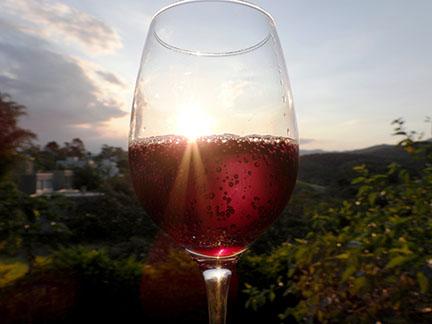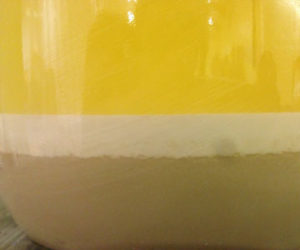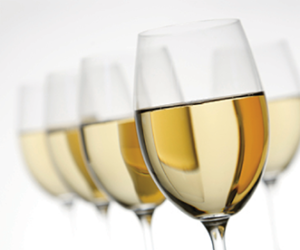
There are many ways to add carbonation to wine — from the traditional méthode champenoise and Charmat methods, to less common and more regional methods. In this article I will present and discuss two traditional Italian winemaking techniques in which second fermentation plays a crucial role: Governo and metodo ancestrale. Both techniques are suitable for home winemaking, yet are often unheard of outside of Italy.
Second fermentation is carried out by living yeast cells that start alcoholic fermentation again, when there still is a fraction of soluble sugars in the wine, and when other factors such as temperature and nutrient content are optimal for microbial growth and fermentation. The second fermentation occurs in the fermenting vat or in the bottle; in both cases, the containers must be sealed so as to capture the forming CO2 gas, which makes the wine sparkling.
For these second fermentation techniques, sugars that cause the fermentation can be added to a base wine, as is the case in the governo technique where dried grapes are added after an initial fermentation; or they can be present in the wine when alcoholic fermentation is not yet completed, as in the case of the metodo ancestrale technique. In both methods the second fermentation, which is the resumption of the activity of yeast cells, causes important changes in the chemical and sensory properties of the wines, which go well beyond the simple formation of CO2 gas. In particular, the changes in the governo are due to the metabolism that occurs in the drying berries; in the sparkling wines obtained with the metodo ancestrale there is the prevalent role of the yeast cells’ autolysis.
Drying of grapes: Governo in the Tuscan tradition
The drying of grapes, both red and white, is a technique mostly used to prepare sweet wines. Grapes are harvested and then dried out to concentrate the sugar levels in their juice through water loss. Traditionally, this drying process is carried out on straw mats and lasts from 1 to 4 months. Weight loss is from 10 to 40% or more. When the drying process is completed, grapes are crushed and the must undergoes fermentation.
In other cases, grapes are left on the vine and are allowed to dry out beyond maturation for a period of time prior to being harvested, crushed, and fermented. In both cases, the concentration of sugars and tartaric acid increase and malic acid decreases because it is a substrate of respiration. During the drying process the cellular metabolism turns progressively to anaerobic. This change has some consequences: Malic acid forms ethanol, ethanol forms esters, and new volatile compounds and phenolic substances are formed. To put it simply, the drying process significantly changes the wine’s sensory properties.
Governo is a traditional technique that was rather common in Tuscany until the 1960s. References to this technique are present in documents from the 18th century, and it was recommended by Bettino Ricasoli in his guidelines to produce Chianti wine in 1834–1837. Today, while less common, governo is finding favor with some red wine producers of central Italy.
After the usual fermentation of red grapes — above all Sangiovese, the flagship red variety in Tuscany — dried berries, normally a smaller percentage of the vintage, are crushed and added to the wine when winter has not yet reached its lowest temperatures. A second fermentation takes place, raising the alcoholic concentration and releasing CO2 gas in the wine, which becomes more crisp and vibrant, with a deeper color due to maceration. The decrease in malic acid, the synthesis of some new aromatic compounds (as described above), and the slight fizzy character, make the wine more drinkable, so it can be sold or consumed earlier than the usual red wines.
In this technique the dried grapes come from a selected vintage and make up about one tenth of the total amount of grapes used for the entire batch. After harvest in mid- or late-September, these grapes are stored to dry on straw mats or on grates. After some weeks, usually in late November, they are destemmed, crushed, and added to wine. A strict control of the temperature is then necessary to let the yeast cells that are present on the berries rapidly ferment the added juice. It is also possible to add commercial yeast strains, selected to ferment in the presence of 10–12% ethanol, which can decrease the risks of a sluggish fermentation.
The final product is a slightly pétillant (fizzy) red wine, with a little higher alcohol content, stronger color, and a renewed, more complex aromatic profile in which fruity hints prevail.
Autolysis of the yeast cells: Lambrusco and Prosecco metodo ancestrale
During fermentation, a significant amount of biomass, consisting of live and dead cells (from 108 to 109 cells/mL) of different species and strains of yeasts is formed; towards the end of the process when these cells begin to die this biomass tends to settle, forming a significant part of the lees. Two kinds of lees can be distinguished: The gross lees, which are mainly formed by sediments deriving from the skins and other parts of the berries; and the fine lees, which are mainly formed by dead cells of the fermenting yeasts. The gross lees tend to settle easily, and are usually separated by the winemakers.
The fine lees, formed after fermentation, can be left for several months in contact with the wine, in the same container, without racking.
The yeasts’ dead cells are made of proteins, nucleic acids, and lipids; these materials tend to slowly degrade, forming peptides, amino acids, nucleotides, and fatty acids, which diffuse from the cells into the wine; from the cell walls derive soluble mannoproteins and polysaccharides.
This process of slow degradation is termed autolysis. A lot of low molecular weight compounds are produced by enzymatic reactions inside the cells — most of which affect the sensory characteristics of the wine. The yeast strain and the duration of this process are important factors that influence the change in the wine quality.
The mannoproteins and the polysaccharides, which have high molecular weight, affect wine sensory properties as well; in general, red and white wines rich in polysaccharides show better mouthfeel and texture, and stabilize the wine color.
Yeast autolysis during aging in bottles accounts for the particular sensory properties of high-quality Champagne produced in France by the methode champenoise: The breakdown of yeast proteins, lipids, and nucleic acids causes an enrichment in the wine of new compounds that make those products unique.
In the Charmat method, autolysis usually does not occur: This technique implies that musts or wines are racked and fermented in pressure-resistant tanks, making the process faster, and saving costs. In general, Charmat sparkling wines rank second in quality in comparison to Champenoise wines.
Yeast autolysis is at the base of the Italian metodo ancestrale (ancestral method), which is used to prepare sparkling Italian wines (particularly in northern Italy) with an artisanal focus; among them, there are some producers of the famous Lambrusco (red) and Prosecco (white), who claim a commitment to natural winemaking. This technique is different from both the Champenoise and the Charmat methods; sugars are not added, musts undergo the second alcoholic fermentation directly in the bottle, and the deposit is not disgorged.
In the metodo ancestrale (also called col fondo, which means “with deposit”) musts are fermented in steel vats; then, the yeast activity is slowed through cooling temperatures so as to obtain a sufficient amount of residual sugars. The wines are transferred to the bottles, which are sealed, and a second fermentation occurs, without adding sugar or yeast cells. At the end of fermentation, the lees slowly degrade for some months, tending to form a deposit at the bottom of the bottles. During this phase, the contact of the fine lees with the maturing wines occurs. After maturation, the sparkling wines are ready to be consumed, having a greater olfactory complexity, and perhaps a scent of bread crust, owing to the presence of the yeast cells. Some haziness can be present, but that is a characteristic of this kind of product. Depending on the taste of the consumers, bottles rest upright before pouring wine in the glass, letting the deposit aggregate at the bottom; otherwise, the hazy wine can be directly consumed.
Typically, dry sparkling wines produced with this technique have 11-12% alcohol and 2.5 atm pressure in the bottle (slightly sparkling). Attention must be paid to the quantity of sugars still present at the beginning of the second fermentation in order to obtain the desired pressure in the bottle. Approximately 4 g/L sugars give 1 atm of CO2 gas. The bottle must resist high pressure (so use sparkling wine bottles), cork stoppers usually have a larger diameter than average corks, and the closure must have a wire cage (or muselet).
This method is also present in the French tradition (also referred as sur lie), as in the case of Blanquette de Limoux méthode ancestrale, a sparkling wine with a settling deposit from the wine region Languedoc Roussillon.
Conclusions
The protagonists of the presented techniques are yeasts, usually the ones that are naturally present in the environment; so, these methods are natural, with no manipulations nor added chemicals. Some complex chemical and microbiological events are involved, which have been disclosed by scientific research in recent times; being only in part explained, they still maintain a certain halo of mystery.
These techniques can be relatively easily practiced in home winemaking because they do not require any specialized equipment. For instance, as regards the metodo ancestrale, it is possible to follow the seasonal variations of temperature: After bottling at the beginning of winter, the wine rests for some months; in spring, with the rise of temperature, a second fermentation starts, caused by the residual sugars and the presence of living yeast cells. At the end of this activity, the wine is dry and moderately crisp, and can quietly mature in the bottle.
The second yeast fermentation gives a special touch thanks to the complex yeast metabolism, which changes sensory characteristics; so, winemakers have the opportunity to give their wine added complexity and originality.
References
• Fleet G.H., Heard G.M., 1993. “Yeasts-growth during fermentation.” Wine Microbiology and Biotechnology. Harwood Academic Publishers.
• Mencarelli F., Bellincontro A., Nicoletti I., Cirilli M.,Muleo R., Corradini D., 2010. “Chemical and Biochemical Change of Healthy Phenolic Fractions in Winegrape by Means of Postharvest Dehydration.” J. Agric. Food Chem. 58:7557–7564.
• Costantini V., Bellincontro A., De Santis D., Botondi R., Mencarelli F., 2006. “Metabolic Changes of Malvasia Grapes for Wine Production during Postharvest Drying.” J. Agric. Food Chem. 54:3334-3340.
• Campo E., Cacho J., Ferreira V., 2008. “The Chemical Characterization of the Aroma of Dessert and Sparkling White Wines (Pedro Ximénez, Fino, Sauternes, and Cava) by Gas Chromatography-Olfactometry and Chemical Quantitative Analysis.” J. Agric. Food Chem. 56:2477–2484.
• Alexandre H., Guilloux-Benatier M., 2006. Yeast autolysis in sparkling wine – a review. Australian Journal of Grape and Wine Research 12:119–127







